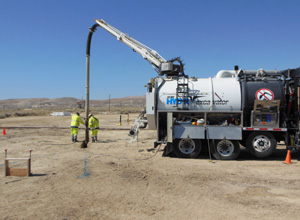April 2015
Matching Your Vacuum Equipment to the Right Job
Ben Schmitt
Product Manager
Vactor Manufacturing
www.vactor.com
With more than 19 million miles of buried utilities in the United States, there are plenty of obstacles to navigate around when performing an excavation project. While services such as One-Call are a great starting point to identify a utility's location, properly exposing a utility is the only sure way to know where that valuable infrastructure truly lies. Electronic locating methods are not always accurate and may also miss unknown utilities in the area.
Visually locating these utilities with vacuum excavation is essential to mitigating risk of striking underground utilities. The risk of striking a fiber-optic, electrical or gas line can result in thousands – and sometimes millions – of dollars in fines, lawsuits and even death.
Selecting the right vacuum excavator
The search for a vacuum excavator begins the same as any piece of equipment: know the job you’re planning to complete. By identifying the type of work your crew will perform, the equipment decision process will run a lot more smoothly.
It’s also helpful to know the size of a typical application so that the correct size debris body is selected to complete the work as efficiently as possible. For example, vacuum excavation manufacturers supply debris capacities ranging from 1 cubic yard of capacity on trailer units and upwards of 21 cubic yards of debris on larger truck-mounted units.
With so many options available to those looking to purchase or rent vacuum excavation equipment, it’s important to consider the size of excavations to be completed with the equipment. Factors to consider include:

- Travel distance to a disposal site
- State and local weight restrictions
- Excavation distance from the unit
- Availability of water
- Soil conditions
- Temperature
Air vs. water
When exploring vacuum excavation systems, the decision between an air or hydro unit is an important one. Both mediums have very distinct advantages.
Air vacuum excavators use compressed air to loosen the soil and positive displacement blowers to vacuum the spoils into a tank. Hydro-excavation uses high-pressure water to loosen soils, and the residual slurry spoils are easily extracted into the debris tank via positive displacement blower or centrifugal compressors.
Air vacuum excavation advantages
Some utility companies, DOTs or power plants specify air vacuum excavation for a given job for a number of reasons. Air vacuum excavation is desired in applications where the soil tends to be loose, water is not readily available, in small-scale excavation projects, or where immediate backfill of the hole is required. When working around buried electrical lines or brittle utilities, air vacuum excavation is often preferred due to the lower operating pressures.
- Air is limitless. Onboard compressors generate the required pressure on demand so there is no need to refill water.
- Air is nonconductive. When vacuuming around live electrical wires, pneumatic excavation can be a preferred choice over hydro-excavation.
- Air vacuum excavation provides dry spoils which can immediately be returned to the excavation site. Many applications in the utility segment require exposing the utility, making the repair, and then backfilling the material. This can’t be done with hydro-excavation.
- Air vacuum excavation uses lower excavation pressures compared to hydro-excavation. Protective coatings and brittle underground utilities can easily be damaged when using hydro-excavation if the operator is not careful.
- Onboard compressors also allow the use of pneumatic tools often required in utility applications.
Hydro-excavation advantages
The key to efficient hydro-excavation is to only use enough water to cut the soil effectively. All too often, operators use more water than is required and spend more time offloading material. Using the proper amount of water for the job will maximize the operator’s efficiency and maximize productivity.
- Hydro-excavation is much faster than air vacuum excavation. Because of its heavier density, water is able to move more material faster and more efficiently.
- In frozen ground or harder materials, water can be heated with on-board water heaters to aid in cutting through these materials.
- Hydro-excavation equipment can often be used for adjacent applications, such as tank and pit cleaning. With the onboard high-pressure water pump, hydro-excavators can perform many alternate applications that cannot be completed with pneumatic excavators.
- Hydro-excavation does not produce the sandblasting effect the way air does. This reduces the potential for damage to underground utilities.
- Water is also a lubricant, which helps to prolong the life of the excavation equipment by reducing wear on the vacuum hose and other components in the air stream. Water also prevents hose clogging.
- Hydro-excavation can be considered less messy, as it does not have the dust component associated with air excavation.
- Hydro-excavation is also quieter than air excavation, so there is less noise fatigue for the operator.
Equipment training is essential
It’s essential that vacuum excavation equipment operators are proficient in the safe and proper use of the equipment to efficiently locate underground utilities while protecting vulnerable and expensive infrastructure. Training – especially in the areas of proper setup, operation, evacuation techniques and load handling – is strongly recommended to ensure that the operator is familiar with the specific method of vacuum excavation so they can safely maximize their efficiency and productivity on the job. While it can take some time to master, excavation technique and nozzle performance can significantly improve overall productivity.
This article is excerpted from the April 2015 Jet News, a benefit of membership in WJTA-IMCA. For more information on membership, click here.